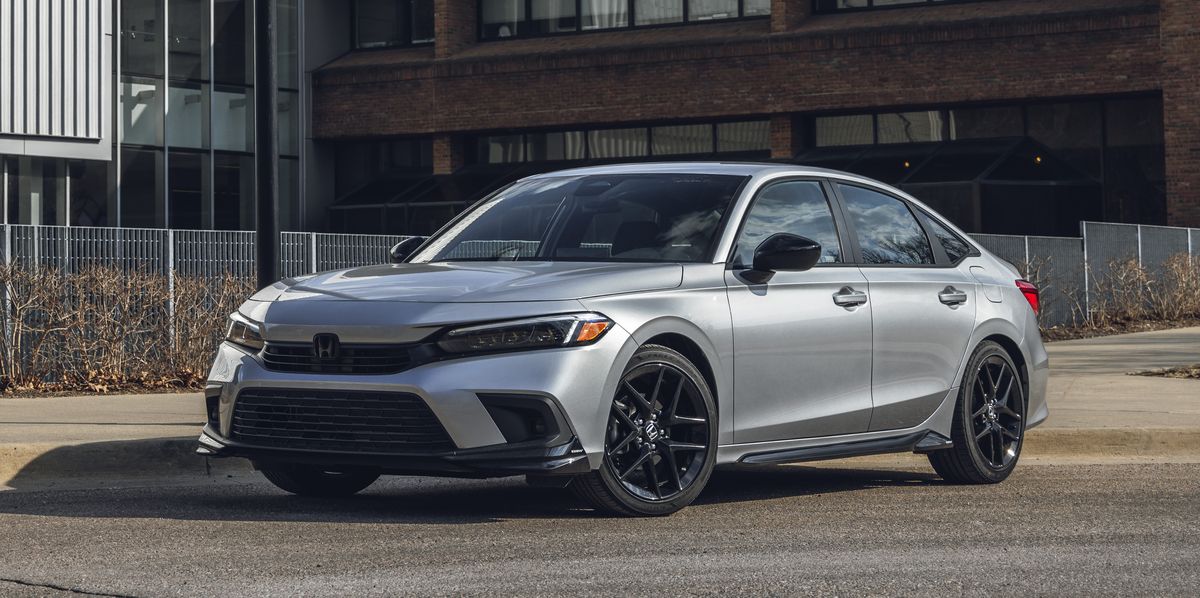Honda Civic Sedan 2023 Safety Features
The advanced safety architecture of the 2023 Honda Civic Sedan is made up of a symphony of high-tech features that have been carefully planned to put the safety of drivers, passengers, and pedestrians first. In a time when technology and safety go hand in hand, this car is a sign of safety on the road. Front airbags, side airbags, and side curtain airbags all work together to protect the driver and passengers. The anti-lock braking system (ABS) keeps the car from skidding when you stop quickly, and the electronic stability control (ESC) keeps the car stable in difficult driving conditions. The adaptive cruise control changes the speed to match the flow of traffic, and the lane departure warning and forward collision warning systems guide and warn you with an electronic hand. The blind-spot tracking system gives you a full view of your surroundings at every turn, and the rearview camera gives you an extra set of eyes for easy reversing. Automatic emergency brakes are ready to kick in if the response time isn’t quick enough, and tire pressure tracking keeps an eye on traction and fuel economy. Pedestrian detection and back cross-traffic alert systems make the driver aware of things that aren’t right in front of the car. As this symphony of safety features plays out, it tells a story of trust, making sure that every trip in the 2023 Honda Civic Sedan is a perfect blend of new technology and safety.
Your Vehicle’s Safety Features

- Safety Cage
- Crush Zones
- Seats and Seat-Backs
- Head Restraints
- Collapsible Steering Column
- Seat Belts
- Front Airbags
- Knee Airbags
- Side Airbags
- Side Curtain Airbags
- Door Locks
- Seat Belt Tensioners
- Outer Lap Pretensioners
The following checklist will help you take an active role in protecting yourself and your passengers.
Your vehicle is equipped with many features that work together to help protect you and your passengers during a crash.
Some features do not require any action on your part. These include a strong steel framework that forms a safety cage around the passenger compartment, front and rear crush zones, a collapsible steering column, and tensioners that tighten the front and rear outer seat belts in a sufficient crash.
However, you and your passengers cannot take full advantage of these features unless you remain seated in the correct position and always wear your seat belts. In fact, some safety features can contribute to injuries if they are not used properly.
Safety Checklist
For the safety of you and your passengers, make a habit of checking these items each time before you drive.
- After everyone has entered the vehicle, be sure all doors are closed and locked. Locking the doors helps prevent an occupant from being ejected and an outsider from unexpectedly opening a door.
Locking/Unlocking the Doors from the Inside - Adjust your seat to a position suitable for driving. Be sure the front seats are adjusted as far to the rear as possible while allowing the driver to control the vehicle. Sitting too close to a front airbag can result in serious or fatal injury in a crash.
Seats
Continuously variable transmission models
- Adjust head restraints to the proper position. Head restraints are most effective when the center of the head restraint aligns with the center of your head. Taller persons should adjust their head restraint to the highest position.
Adjusting the Front Head Restraints - Always wear your seat belt, and make sure you wear it properly. Confirm that any passengers are properly belted as well.
Fastening a Seat Belt - Protect children by using seat belts or child seats according to a child’s age, height, and weight.
Child Safety
If the door and/or trunk open message appears on the driver information interface, a door and/or the trunk is not completely closed. Close all doors and the trunk tightly until the message disappears.
Warnings

FAQ
Answer: Safety features are designed to help prevent accidents and protect occupants in the event of a collision or other hazardous situations.
Answer: The 2023 Civic Sedan typically includes front airbags, side airbags, and side curtain airbags to provide protection in various collision scenarios.
Answer: ABS prevents the wheels from locking up during hard braking, allowing the driver to maintain steering control and reduce the risk of skidding.
Answer: ESC helps drivers maintain control of the vehicle during skids or loss of traction by selectively applying brakes to individual wheels.
Answer: Adaptive cruise control adjusts the vehicle’s speed to maintain a safe following distance from the vehicle ahead.
Answer: Lane departure warning alerts the driver if the vehicle unintentionally drifts out of its lane without using a turn signal.
Answer: Forward collision warning alerts the driver if a potential frontal collision is detected, giving them time to react and avoid a collision.
Answer: Yes, blind-spot monitoring detects vehicles in the driver’s blind spots and provides warnings to help avoid collisions during lane changes.
Answer: The rearview camera provides a view of the area behind the vehicle to help the driver avoid obstacles and pedestrians when reversing.
Answer: Automatic emergency braking senses an impending collision and automatically applies the brakes if the driver doesn’t respond in time.
Answer: TPMS alerts the driver when tire pressure is significantly low, helping to prevent tire-related accidents and improve fuel efficiency.
Answer: Pedestrian detection identifies pedestrians in or near the vehicle’s path and provides alerts or automatic braking to prevent collisions.
Answer: Depending on the model, you may have the option to adjust the sensitivity or settings of certain safety features.
Answer: Rear cross-traffic alert detects approaching vehicles from the sides when reversing and provides warnings to prevent collisions.
Answer: The Civic Sedan’s comprehensive safety features provide drivers with a heightened sense of confidence and security, enabling safer journeys for both the occupants and other road users.
Useful Links:
View Full PDF: Honda Civic Sedan 2023 |Auto User Guide
Honda Civic Hatchback 2023 Fuses Guidelines


